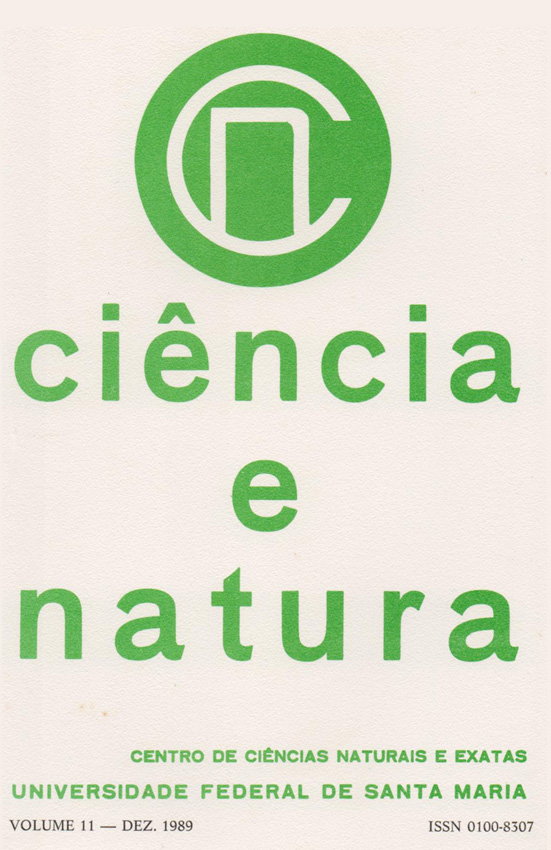Potentializing effect of Cymbopogon citratus – Stapf on acetylcholine action in smooth muscle contration
DOI:
https://doi.org/10.5902/2179460X25535Abstract
Authors searched actions of Cymbopogon citratus-Stapf aquous extract, 2% concentration, on montility of smooth muscle. It were performed 10 (ten) experiments, each of them consisted of the motility record of a segment of duodenum from male Wistar rats maintained in a Tyrode solution water-bath to isolated organ. Physiological parameters (temperature, pH, oxigen supply) were controled to obtain the functional nature of organ motility. It were realized three records to each experiment in this sequency:
First record: control record (standard) from motility of duodenum smooth muscle in Tyrode bath.
Second record: after addition of 0,5 ml physiological solution before the third record, the bath liquid was entirely substituted and the organ was washed tith Tyrode solution.
Third record: after 15 (fifteen) minutes from the addition of Cymbopogon citratus-Stapf tea 2% concentration, it was add 0,5ml acetylcholine solution (11,8165 Mg in 50 ml physiological solution).
It was verified that it shows a significant difference between 2nd and third record groups compared whit control records (first record groups) on smooth muscle motility of isolated duodenum from Wistar male rats.
Downloads
References
ABEGAS, B. & YOHANNES, P.G.J. Nat. Prod. 46(3) :424-6, 19B3.
ARAUJO, A.A. Principais gramíneas do Rio Grande do Sul, Porto Alegre, Sulina, 255p.
CARVALHO, A.R.D. Acura pelas plantas e diversos meios de grande poder curativo, São Paulo, Folco Masucci, 1970.
CORREIA, A.A. et alii: Garcia de Orta, 8(3):629-38, 1960.
CORREIA, A.A. et alii: Garcia de Orta, 10(1):103-9, 1962.
CRAWFORD, M. et alii: Tetrahedron Lett, 35:3099-102, 1975.
CHIORI, C.O. et alii: J. Pharmac. Med. Sci., 1:267-70, 1977.
DIMITRIM, J. Enciclopédia Argentina de agricultura e jardinaria. 2ª ed. Buenos Aires, Acme S.A.C.I., 1972.
DIXON, W.J. & MASSEY, Jr. F.J. Introduction to Statistical Analysis Mc Graw Hill, 3 ed. U.S.A.; 1969, 629p.
FERREIRA, M.S.C. et alii: Reunião Anual SBPC, 35 - Belém, 6-13, julho, 1983.
FERREIRA, M.S.C.; & FONTELES, M.C. Simpósio de plantas medicinais do Brasil, 8 - Manaus, 6 set. Resumos, HITA, 1984, 729p.
GEMTCHUJNICOV, I.D. Manual de Taxonomia Vegetal: plantas de interesse econômico. São Paulo, Agronômica ceres, 1976, 368p.
GYANE, D.O. Drug. Cosmt. Ind. 118: 36-8-40, 1976.
HAUSON, S.W. et alii: Phytochem,15: 1074-5,1976.
JOLY, A.B. Botânica: Introdução e Taxonomia Vegetal, São Paulo, 1975.
KOKATE, C.K. & VARMA, K.C. Sci. Culto 37:196, 1971.
LEUNG, A.Y. Encyclopedia of common natural ingrediente used in food, drugs and cosmetics. New York, 1980.
MARTINDALE: The Extra Pharmacopeia, 289 ed., London Pharmaceutical, 2025, 1982.
MOREIRA, F. As plantas curam, São Paulo, Hemus, 1971.
NEYBERG, A.G. Bull Agr. Congo Belga, 44: 319, 1953.
OLANIYI, A.A. et alii: Planta Médica. 28, 186-9, 1975.
OLIVEROS, B.L. & AUREUS, E. Int. Cong. Essent. Oils. 7:166,1979.
ONAWUNMI, G.O. et alii: J. Ethno pharmacol. 12(3):279-86,1984.
PERRY, W.L.M. Pharmacological experimentoon isolected preparations, S. Livingston, London, 163p.
RABHA, L.C. et alii: Indian perfum. 23:178, 1979.
RAMADAN, F.M. et alii: Chem. Mikribiol. Technol., Lebensm, 1:96, 1972.
ROVESTI, P. & VARIATI, G.L. Fr. Ses. Perfums, 3:39, 1960.
SETH, G. et alii: Indian, J. Exp. Bid., 14:370, 1976.
SILVA, G.A.A.B. & BAUER, L. Rev. Bras. Farma., 52(4):193-6, 1971.
SIMÕES, C.M.O.; MENTZ, L.A. Schenkel, e.p., Irgang, B.E. e Stehmann, J.R, Plantas da medicina popular do Rio Grande do Sul, ed. da UFRGS, Porto Alegre, 1986.
SMITH, L.B. Wasshansen, DC Klain, R.M. Flora Ilustrada Catarinense-Gramineas, Raulino Reitz, Itajai, 1982, 174p.
SOFOWORA, E.A. & ISAAVES, W.A. Nat. Prod., 34: 383, 1971.
SYLVA, M.G. de Mfq. Chemist., 30:415, 1959.
VALE, J.C. Bolo Esc. Farm. 629-38, Portugal, 1966.
Downloads
Published
How to Cite
Issue
Section
License
To access the DECLARATION AND TRANSFER OF COPYRIGHT AUTHOR’S DECLARATION AND COPYRIGHT LICENSE click here.
Ethical Guidelines for Journal Publication
The Ciência e Natura journal is committed to ensuring ethics in publication and quality of articles.
Conformance to standards of ethical behavior is therefore expected of all parties involved: Authors, Editors, Reviewers, and the Publisher.
In particular,
Authors: Authors should present an objective discussion of the significance of research work as well as sufficient detail and references to permit others to replicate the experiments. Fraudulent or knowingly inaccurate statements constitute unethical behavior and are unacceptable. Review Articles should also be objective, comprehensive, and accurate accounts of the state of the art. The Authors should ensure that their work is entirely original works, and if the work and/or words of others have been used, this has been appropriately acknowledged. Plagiarism in all its forms constitutes unethical publishing behavior and is unacceptable. Submitting the same manuscript to more than one journal concurrently constitutes unethical publishing behavior and is unacceptable. Authors should not submit articles describing essentially the same research to more than one journal. The corresponding Author should ensure that there is a full consensus of all Co-authors in approving the final version of the paper and its submission for publication.
Editors: Editors should evaluate manuscripts exclusively on the basis of their academic merit. An Editor must not use unpublished information in the editor's own research without the express written consent of the Author. Editors should take reasonable responsive measures when ethical complaints have been presented concerning a submitted manuscript or published paper.
Reviewers: Any manuscripts received for review must be treated as confidential documents. Privileged information or ideas obtained through peer review must be kept confidential and not used for personal advantage. Reviewers should be conducted objectively, and observations should be formulated clearly with supporting arguments, so that Authors can use them for improving the paper. Any selected Reviewer who feels unqualified to review the research reported in a manuscript or knows that its prompt review will be impossible should notify the Editor and excuse himself from the review process. Reviewers should not consider manuscripts in which they have conflicts of interest resulting from competitive, collaborative, or other relationships or connections with any of the authors, companies, or institutions connected to the papers.






